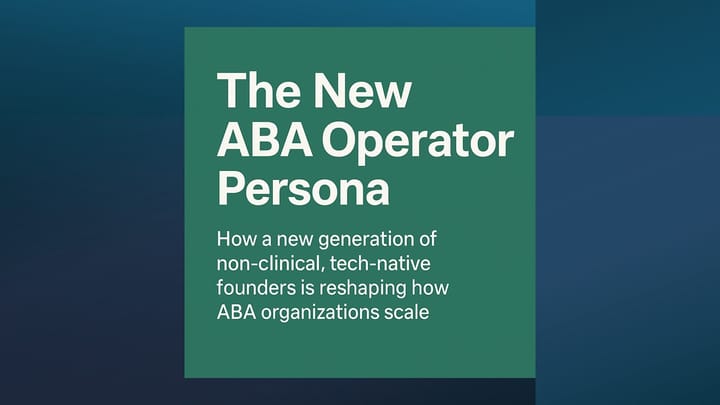Bold Prediction: AI Will Actually Create Jobs in the Autism Field

Nearly every recent conversation I’ve had with friends and colleagues carries an undercurrent of anxiety about what artificial intelligence will mean for people trying to find and keep good jobs. The tone is often uneasy — as if the shift has already begun and there’s no turning back.
That fear is understandable. Every major technological disruption starts this way. The same concerns surfaced with the arrival of the printing press, the industrial revolution, and the personal computer. Each wave displaced familiar roles — and yet each ultimately created new ones, often more fulfilling and better paid than what came before.
But the autism field isn’t just any labor market. It faces three deeply rooted structural challenges that have long constrained access to care and limited its potential to scale sustainably:
- High staff turnover and burnout
- Low reimbursement rates
- Lack of agreed-upon outcomes that justify consistent payor coverage
AI, applied thoughtfully, has the potential to reduce each of these friction points — and in doing so, expand both the number and quality of jobs in the field.
1. Tackling Turnover Through Better Work
Autism therapy is profoundly human. It depends on presence, empathy, and relationships. But the work is often grueling — unpredictable schedules, limited mentorship, heavy documentation, and little time for reflection or growth. The result: high burnout and high turnover.
AI can relieve many of those pressures. Automation in scheduling, note generation, and quality checks reduces “busy work.”
Machine learning can match staff to the right caseloads, anticipate cancellations, and create more predictable schedules.
Intelligent coaching and cohort-based training tools can personalize professional development, helping new technicians and BCBAs learn faster and feel more supported.
And increasingly, many operators — former professionals from finance, logistics, and education seeking stability in an AI-uncertain economy — are gravitating toward autism therapy precisely because it still values the human connection that algorithms can’t replace. They’re bringing with them new management skills, systems thinking, and digital literacy that will strengthen the field even further.
When clinicians and operators alike spend more time doing good work — not paperwork — retention improves. AI doesn’t replace the human connection at the center of therapy; it makes that connection more sustainable.
2. Turning Data Into Justification for Higher Reimbursement
Reimbursement rates are the economic backbone of autism care — and they’ve barely moved in a decade. Payors hesitate to raise rates when outcome data feels inconsistent or subjective. The problem isn’t that data doesn’t exist; it’s that no one has been able to prove its effectiveness at scale.
AI can finally change that. By ingesting and analyzing massive, multimodal datasets — phenotypes, video capture, human-coded observations, genetic markers, and comorbidities like speech or ADHD — we can move from correlation to causation. We can begin to answer, with real precision, which combinations of therapy intensity, environment, and clinician experience actually drive developmental progress.
And it’s not just startups pursuing this. Major research institutions, children’s hospitals, and universities are now deploying AI models to mine therapy data for predictive insights — experiments that could eventually establish universally accepted outcome frameworks. Their discoveries will ripple across practice management, insurance policy, and even public health.
That shift — from scattered progress charts to large-scale, validated outcome models — could reshape how therapy is planned, delivered, and funded. When results are clear and replicable, reimbursement can evolve toward value-based care that’s both predictable and defensible. And with that, the entire labor market stabilizes.
3. Building Career Ladders Through Specialization and Integration
As outcomes become more measurable and care becomes more integrated, autism therapy will start to look more like other medical disciplines where innovation compounds. Shared data models, common treatment forms, and interdisciplinary care pathways will create predictability — and with it, specialization.
That means new and better-compensated roles. Technicians could grow into analysts, supervisors, or care coordinators. Behavior analysts could expand into speech, occupational, or integrative care. New specialties will emerge in data quality, clinical analytics, and care innovation — roles that simply didn’t exist five years ago.
And there’s an entire parallel story unfolding on the platform side. Vendors and startups building AI-powered scheduling, claims, documentation, and outcomes tools will need product managers, data scientists, prompt engineers, and clinician-technologists who understand both therapy and technology. The next wave of growth in autism won’t just happen in clinics — it will happen in the infrastructure that supports them.
In short, AI can professionalize the field from both directions: more rewarding clinical work and more sophisticated technology careers to match.
My Story Is an ABA Story Too
My own career has followed a similar arc. I’ve worked in autism services for years — as an operator, technologist, and now analyst — but it wasn’t until I began using AI tools that I truly grasped the complexity and interdependence of this industry.
AI has given me the ability to see patterns in what once felt like noise: hiring trends, reimbursement shifts, platform adoption, and the operational bottlenecks that shape access to care. The more I use these tools — and the more conversations I have with clinicians, executives, investors, and platform founders — the more I realize how much there still is to learn.
Between hundreds of AI prompts and daily dialogue with people across the ecosystem, I learn something new about this field every single day. Those conversations, and the insights they spark, have become the foundation of MissionViewpoint.com.
In just one year, what began as a side project has become the fastest-growing source of in-depth content in the ABA technology space, with:
- Over 120 original, in-depth, free, no-fluff articles
- Roughly 2,000 unique monthly readers, many of them C-suite leaders across providers, platforms, and investors
None of that reach or insight would have been possible without AI. The same technology now reshaping therapy workflows is what allowed me to connect dots across data, operations, and care delivery — and to make sense of an industry too complex to see clearly without it.
The Broader Takeaway
If AI can help one operator make sense of a complex system, imagine what it can do for the entire field. By reducing turnover, strengthening outcome evidence, and unlocking new reimbursement pathways, AI could make autism therapy more stable, more respected, and more rewarding — both clinically and financially.
The autism field will continue to need therapists, supervisors, data analysts, technologists, and now AI integrators — people who bridge care and computation. Far from eliminating jobs, AI may prove to be the biggest creator of them yet.
I’m not certain how most industries will look a few years from now. My suspicion is that AI will create more opportunity than we have today outside of autism care.
But my conviction about autism is solid — this field will grow, evolve, and continue to need more humans than ever.
And that will be, in no small part, because of AI.
👉 Subscribe to the ABA Mission Newsletter for regular insights into ABA strategy, tech platforms, and investment activity.
🔗 Sign up here



